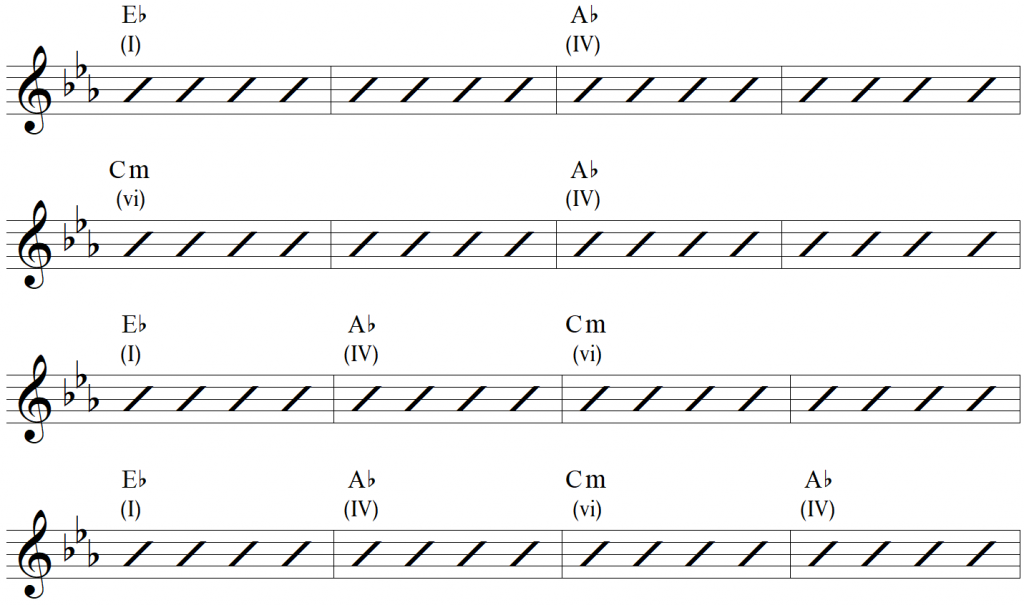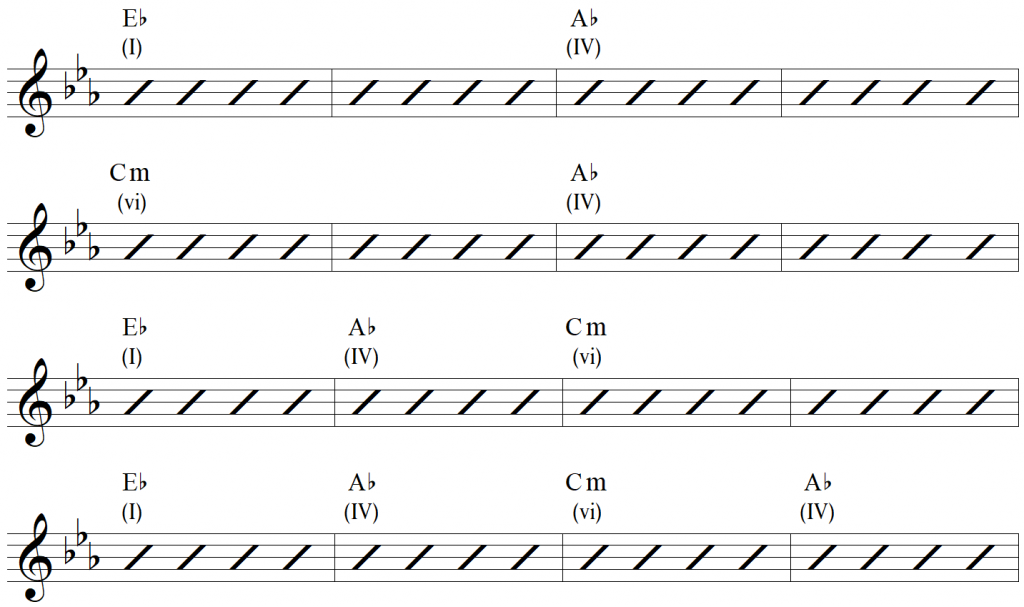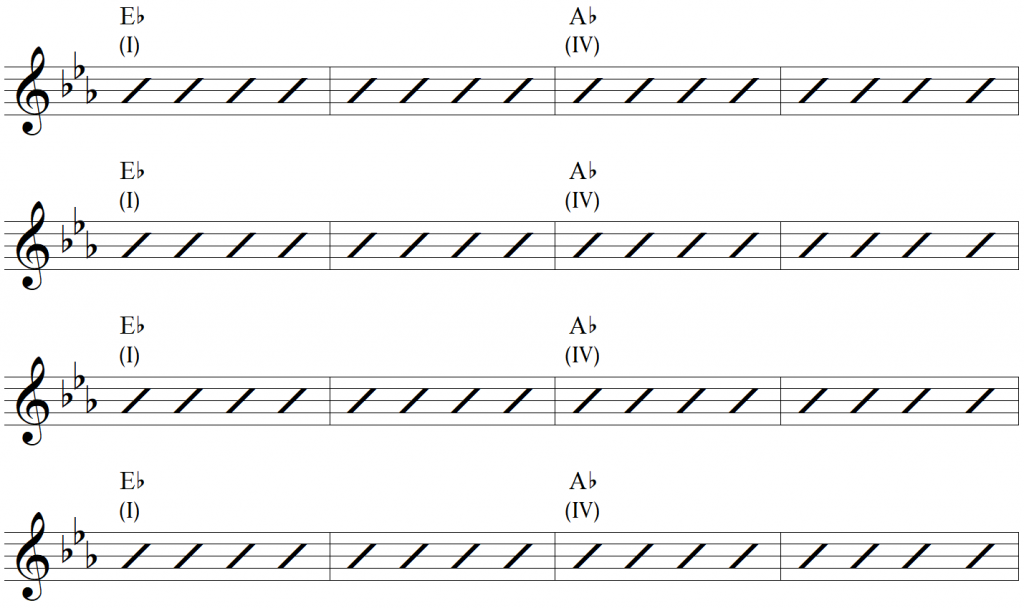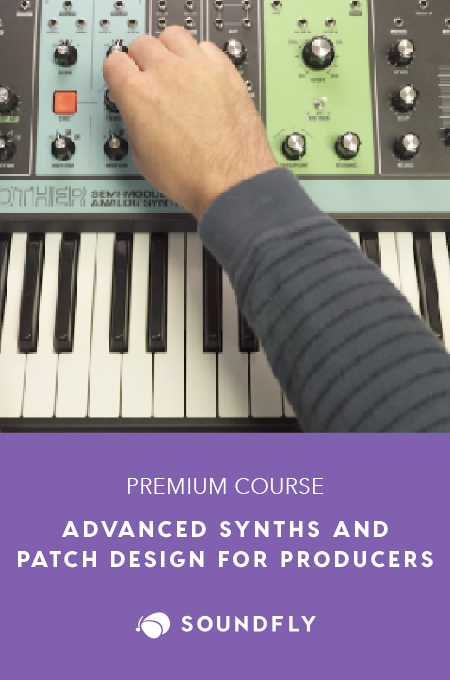Have you heard Macklemore and Kesha’s recent duet, “Good Old Days”? It’s got a main theme everyone can relate to: “why, oh why, did I take those days gone by for granted?” The video features some pretty universal moments as well, just driving through the woods in a van at various states of chill along the way.
It all seems pretty simple at first glance — but let’s see what we might find if we dig a bit deeper, shall we?
First off, the song is in the key of E♭ major. So, sorry, guitar players, but you know what to do: Tune down to E♭ like Slash or Stevie Ray Vaughn do all the time. Sure, you could play the chords in higher frets, but come on, E♭ is a deep-sounding key for a deep song. Oh, and if you want to go a bit deeper in learning how to coax complex emotions out of chords and keys, check out a free preview of Soundfly’s Unlocking the Emotional Power of Chords course!
Alright, so here are the chords for the first couple sections, all diatonic (native to E♭ major.)
The Piano Intro [at 0:00]

Kesha’s chorus begins at 0:15 and features the same chord progression established in the intro.
Kesha’s Post-Chorus/Refrain Thing [at 0:31]

Okay, the first indication we may have something more than “simple” here is in the hard-to-classify second half of the chorus thingamabob. And, we also can’t be sure it’s the chorus yet, because we haven’t heard it repeated, but we did hear the intro chords repeated, as they became the first eight bars of this section.
With this expectation met, the next four bars feel like extended material, maybe like a refrain, or we might call it a post-chorus. Ever hear of a “pre-chorus,” or a chunk of music that sets up the chorus? Well, this section, with its own distinct length and character, feels like something of an afterthought, like she’s winding down. A post-chorus, why not?
Whatever you call it, part of what gives this subsection its own character is that it takes the beginning of the opening progression and halves it. Look back up at the chords: E♭ and A♭ were eight beats long each, and now they’re only four beats. The Rolling Stones’ “(I Can’t Get No) Satisfaction” is another perfect example of a song that employs the “halving-of-a-form” play.
This can be dangerous though. One consequence of using this technique is that since you burn through your chords twice as fast, it feels like it’s over too quickly. Over too quickly — kind of like them good old days, eh?
All that said, you could “simplify” this whole thing by just calling the whole darn 12-bar progression the chorus.
Macklemore’s First Verse [at 0:38]

Next up, Macklemore’s verse also halves the E♭ to A♭ chord change in the middle. And then, notice how that second Cm chord (bar 11) is left hanging for eight beats, so that the A♭ that comes after the third Cm feels more like it resolves by contrast.
And real quick, as a Minnesotan, I can’t let the, “Snow outside of First Ave” shout-out in the lyrics slide by uncommented on. (I happen to live on Third Ave myself.) The “small club” he refers to is most definitely the 7th St. Entry, the sidekick club attached to First Avenue, and the stars he wants his name on look like this:

Anyway, where was I? Ah yes, 12-bar chorus, 16-bar verse. Hey! Wait a sec, how come Macklemore gets four more measures than Kesha? This song is sexist! Just kidding… we’ll see why later.
+ Learn more with Soundfly: Write better pieces of music with a more thorough understanding of the foundational elements of composition and one-on-one help from a professional mentor in Introduction to the Composer’s Craft. (*Discount code below!)
Kesha’s Chorus > Post-Chorus Repeated [at 1:11]
Let’s talk melody for a sec. The melody is mainly using a pentatonic scale, save for one quick “fa” (four) on the “less” in “reckless.” But other than that, no “ti” (or sevens) at all. Of course, the shortage of “ti” in modern pop music, and the shortage of V chords that that affects (did you happen to notice that there are no V chords in this song yet?), is an entirely separate article. I know because I wrote that article for Flypaper. So we can just throw this song on that pile.
And to continue with the melody, I really dig the fluttery grace notes Kesha sings on the lyric “old.” The first time she sings it, she approaches from the note above, and you don’t hear that too often in pop music. It sounds refreshing! This vocal ornament is called an acciaccatura in more polished circles.
The next few times she sings it, she both approaches from the note below and the note above, then even throws in a little vibrato for a vocal ornamentation beyond the ken of most mortals. Slow it down to 50% in the YouTube settings (or your favorite music slow-down app) around 1:31 to get a full appreciation of what I’m talking about.
Macklemore’s Second Verse [at 1:33]
Here he is again! Man, every time Macklemore comes back in, it feels to me like Kesha hasn’t finished her bit yet. Could this be a result of that eight-bar motif shrinking to four bars thing?
This also reminds me of the Black Eyed Peas’ “I Gotta Feeling,” which uses the same “I – IV – vi – IV” changes and rolls along at a similar tempo, which is, um, hang on… 128 bpm. “Good Old Days” clocks in at a more relaxed 124 bpm.
Now, I want you to listen for the five “Woo-oo’s” in bars nine, 10, 12, 13, and 14. Very tasteful placements, don’t you think? I mean, don’t you just hate it these days when the new tracks overdo it with the “woo-oo’s”?
Kesha’s Chorus > Post-Chorus Comes Back Around! [at 2:05]
Let’s dig into this Gm (iii) chord for a minute. It’s the most uncommon major key diatonic that’s a major or minor triad. It’s a really deflating chord, which usually you don’t want because it can kill momentum, but for a song like this, it works perfectly to suspend the drive for a bit to leave room for a little reflection.
How do I know that the (iii) chord is less common than the I, ii, IV, V and vi chords? Because I did a macro study of chords in pop tunes here and another one on chords in Disney songs (because, you know, time is something of which I apparently have too much).
Macklemore and Kesha’s Modified Third Verse (or First Bridge) [at 2:28]

The question, now that we’ve gotten this far, is whether this part is another verse subsection or the bridge? Chord-wise it’s mostly the same as the Macklemore verses — just one chord different to keep your expectations engaged. One other thing that sets it apart from verses one and two is that Kesha joins in this time, which both raises the stakes and Macklemore’s singing, so you know you must be nearing the peak.
But why I’d maybe lean towards calling this a third “modified” verse over a bridge is, one, the next section can’t really be called anything but a bridge; and two, the presence of what I’ll call a verse refrain, or “title refrain.” It’s the lyric, “Those good old days” that ends this section, as well as verses one and two, that really ties them all together as variations of the same section idea.
Macklemore and Kesha’s Bridge (or, Second Bridge?) [at 3:00]

What is significant here is that it’s just two chords for all 16 bars. We kind of expect that there’s going to be a different chord to start that ninth bar, but it never does. If I could describe the tension this creates, it would be like pulling a rubber band back to fire across the lunchroom, and then instead of firing it, you pull it back twice as far. The anticipation created by this repetition is palpable.
Kesha’s Chorus > Post-Chorus to Take Us Home [at 3:31]
Now we see why Kesha only gets 12 bars and Macklemore gets 16; she gets to bookend the song, and it’s his song! Speaking of bookends, notice how Kesha sings it all much cleaner this last time — no gritty rasp on words like “would,” “nights,” or “magic”? She also sang it pretty like this to start the song, saving the rasp for the middle. It’s a nuanced thing, but this is where they put the “pro” in producer; very well thought-out, well-crafted song here. Kudos.
So, there you go. The moral of the song is: Appreciate today, for today is tomorrow’s “good old day.” And, hey, Macklemore, keep cutting hits like this, and you’ll get your name up on one of those silver First Avenue stars someday…
Oh wait. Never mind, there you go. Nice one, brova!

Looking to advance your skills and capabilities? Explore Soundfly’s growing array of Mainstage courses that feature personal support and mentorship from experienced professionals in the field, such as Faders Up: Modern Mixing Techniques, Orchestration for Strings, Unlocking the Emotional Power of Chords, and Beat Making with Ableton Live.
Sign up for the next round of courses starting October 4, and get 40% off (that’s $200!) with code LASTCHANCE.





